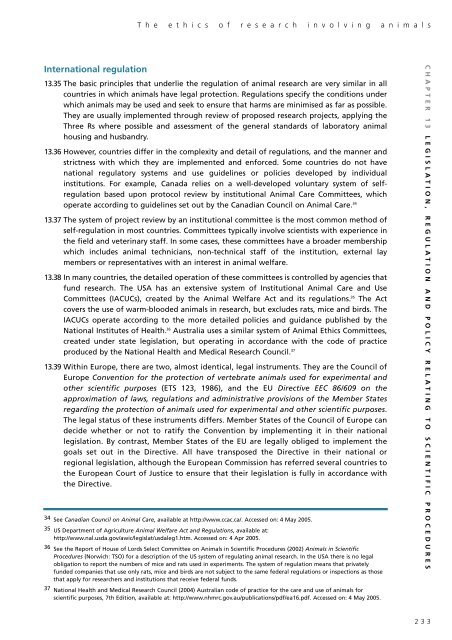The ethics of research involving animals - Nuffield Council on ...
The ethics of research involving animals - Nuffield Council on ...
The ethics of research involving animals - Nuffield Council on ...
You also want an ePaper? Increase the reach of your titles
YUMPU automatically turns print PDFs into web optimized ePapers that Google loves.
T h e e t h i c s o f r e s e a r c h i n v o l v i n g a n i m a l s<br />
Internati<strong>on</strong>al regulati<strong>on</strong><br />
13.35 <str<strong>on</strong>g>The</str<strong>on</strong>g> basic principles that underlie the regulati<strong>on</strong> <str<strong>on</strong>g>of</str<strong>on</strong>g> animal <str<strong>on</strong>g>research</str<strong>on</strong>g> are very similar in all<br />
countries in which <str<strong>on</strong>g>animals</str<strong>on</strong>g> have legal protecti<strong>on</strong>. Regulati<strong>on</strong>s specify the c<strong>on</strong>diti<strong>on</strong>s under<br />
which <str<strong>on</strong>g>animals</str<strong>on</strong>g> may be used and seek to ensure that harms are minimised as far as possible.<br />
<str<strong>on</strong>g>The</str<strong>on</strong>g>y are usually implemented through review <str<strong>on</strong>g>of</str<strong>on</strong>g> proposed <str<strong>on</strong>g>research</str<strong>on</strong>g> projects, applying the<br />
Three Rs where possible and assessment <str<strong>on</strong>g>of</str<strong>on</strong>g> the general standards <str<strong>on</strong>g>of</str<strong>on</strong>g> laboratory animal<br />
housing and husbandry.<br />
13.36 However, countries differ in the complexity and detail <str<strong>on</strong>g>of</str<strong>on</strong>g> regulati<strong>on</strong>s, and the manner and<br />
strictness with which they are implemented and enforced. Some countries do not have<br />
nati<strong>on</strong>al regulatory systems and use guidelines or policies developed by individual<br />
instituti<strong>on</strong>s. For example, Canada relies <strong>on</strong> a well-developed voluntary system <str<strong>on</strong>g>of</str<strong>on</strong>g> selfregulati<strong>on</strong><br />
based up<strong>on</strong> protocol review by instituti<strong>on</strong>al Animal Care Committees, which<br />
operate according to guidelines set out by the Canadian <str<strong>on</strong>g>Council</str<strong>on</strong>g> <strong>on</strong> Animal Care. 34<br />
13.37 <str<strong>on</strong>g>The</str<strong>on</strong>g> system <str<strong>on</strong>g>of</str<strong>on</strong>g> project review by an instituti<strong>on</strong>al committee is the most comm<strong>on</strong> method <str<strong>on</strong>g>of</str<strong>on</strong>g><br />
self-regulati<strong>on</strong> in most countries. Committees typically involve scientists with experience in<br />
the field and veterinary staff. In some cases, these committees have a broader membership<br />
which includes animal technicians, n<strong>on</strong>-technical staff <str<strong>on</strong>g>of</str<strong>on</strong>g> the instituti<strong>on</strong>, external lay<br />
members or representatives with an interest in animal welfare.<br />
13.38 In many countries, the detailed operati<strong>on</strong> <str<strong>on</strong>g>of</str<strong>on</strong>g> these committees is c<strong>on</strong>trolled by agencies that<br />
fund <str<strong>on</strong>g>research</str<strong>on</strong>g>. <str<strong>on</strong>g>The</str<strong>on</strong>g> USA has an extensive system <str<strong>on</strong>g>of</str<strong>on</strong>g> Instituti<strong>on</strong>al Animal Care and Use<br />
Committees (IACUCs), created by the Animal Welfare Act and its regulati<strong>on</strong>s. 35 <str<strong>on</strong>g>The</str<strong>on</strong>g> Act<br />
covers the use <str<strong>on</strong>g>of</str<strong>on</strong>g> warm-blooded <str<strong>on</strong>g>animals</str<strong>on</strong>g> in <str<strong>on</strong>g>research</str<strong>on</strong>g>, but excludes rats, mice and birds. <str<strong>on</strong>g>The</str<strong>on</strong>g><br />
IACUCs operate according to the more detailed policies and guidance published by the<br />
Nati<strong>on</strong>al Institutes <str<strong>on</strong>g>of</str<strong>on</strong>g> Health. 36 Australia uses a similar system <str<strong>on</strong>g>of</str<strong>on</strong>g> Animal Ethics Committees,<br />
created under state legislati<strong>on</strong>, but operating in accordance with the code <str<strong>on</strong>g>of</str<strong>on</strong>g> practice<br />
produced by the Nati<strong>on</strong>al Health and Medical Research <str<strong>on</strong>g>Council</str<strong>on</strong>g>. 37<br />
13.39 Within Europe, there are two, almost identical, legal instruments. <str<strong>on</strong>g>The</str<strong>on</strong>g>y are the <str<strong>on</strong>g>Council</str<strong>on</strong>g> <str<strong>on</strong>g>of</str<strong>on</strong>g><br />
Europe C<strong>on</strong>venti<strong>on</strong> for the protecti<strong>on</strong> <str<strong>on</strong>g>of</str<strong>on</strong>g> vertebrate <str<strong>on</strong>g>animals</str<strong>on</strong>g> used for experimental and<br />
other scientific purposes (ETS 123, 1986), and the EU Directive EEC 86/609 <strong>on</strong> the<br />
approximati<strong>on</strong> <str<strong>on</strong>g>of</str<strong>on</strong>g> laws, regulati<strong>on</strong>s and administrative provisi<strong>on</strong>s <str<strong>on</strong>g>of</str<strong>on</strong>g> the Member States<br />
regarding the protecti<strong>on</strong> <str<strong>on</strong>g>of</str<strong>on</strong>g> <str<strong>on</strong>g>animals</str<strong>on</strong>g> used for experimental and other scientific purposes.<br />
<str<strong>on</strong>g>The</str<strong>on</strong>g> legal status <str<strong>on</strong>g>of</str<strong>on</strong>g> these instruments differs. Member States <str<strong>on</strong>g>of</str<strong>on</strong>g> the <str<strong>on</strong>g>Council</str<strong>on</strong>g> <str<strong>on</strong>g>of</str<strong>on</strong>g> Europe can<br />
decide whether or not to ratify the C<strong>on</strong>venti<strong>on</strong> by implementing it in their nati<strong>on</strong>al<br />
legislati<strong>on</strong>. By c<strong>on</strong>trast, Member States <str<strong>on</strong>g>of</str<strong>on</strong>g> the EU are legally obliged to implement the<br />
goals set out in the Directive. All have transposed the Directive in their nati<strong>on</strong>al or<br />
regi<strong>on</strong>al legislati<strong>on</strong>, although the European Commissi<strong>on</strong> has referred several countries to<br />
the European Court <str<strong>on</strong>g>of</str<strong>on</strong>g> Justice to ensure that their legislati<strong>on</strong> is fully in accordance with<br />
the Directive.<br />
34 See Canadian <str<strong>on</strong>g>Council</str<strong>on</strong>g> <strong>on</strong> Animal Care, available at http://www.ccac.ca/. Accessed <strong>on</strong>: 4 May 2005.<br />
35 US Department <str<strong>on</strong>g>of</str<strong>on</strong>g> Agriculture Animal Welfare Act and Regulati<strong>on</strong>s, available at:<br />
http://www.nal.usda.gov/awic/legislat/usdaleg1.htm. Accessed <strong>on</strong>: 4 Apr 2005.<br />
36 See the Report <str<strong>on</strong>g>of</str<strong>on</strong>g> House <str<strong>on</strong>g>of</str<strong>on</strong>g> Lords Select Committee <strong>on</strong> Animals in Scientific Procedures (2002) Animals in Scientific<br />
Procedures (Norwich: TSO) for a descripti<strong>on</strong> <str<strong>on</strong>g>of</str<strong>on</strong>g> the US system <str<strong>on</strong>g>of</str<strong>on</strong>g> regulating animal <str<strong>on</strong>g>research</str<strong>on</strong>g>. In the USA there is no legal<br />
obligati<strong>on</strong> to report the numbers <str<strong>on</strong>g>of</str<strong>on</strong>g> mice and rats used in experiments. <str<strong>on</strong>g>The</str<strong>on</strong>g> system <str<strong>on</strong>g>of</str<strong>on</strong>g> regulati<strong>on</strong> means that privately<br />
funded companies that use <strong>on</strong>ly rats, mice and birds are not subject to the same federal regulati<strong>on</strong>s or inspecti<strong>on</strong>s as those<br />
that apply for <str<strong>on</strong>g>research</str<strong>on</strong>g>ers and instituti<strong>on</strong>s that receive federal funds.<br />
37 Nati<strong>on</strong>al Health and Medical Research <str<strong>on</strong>g>Council</str<strong>on</strong>g> (2004) Australian code <str<strong>on</strong>g>of</str<strong>on</strong>g> practice for the care and use <str<strong>on</strong>g>of</str<strong>on</strong>g> <str<strong>on</strong>g>animals</str<strong>on</strong>g> for<br />
scientific purposes, 7th Editi<strong>on</strong>, available at: http://www.nhmrc.gov.au/publicati<strong>on</strong>s/pdf/ea16.pdf. Accessed <strong>on</strong>: 4 May 2005.<br />
CHAPTER 13 LEGISLATION, REGULATION AND POLICY RELATING TO SCIENTIFIC PROCEDURES<br />
233
















